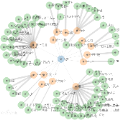CCKS 2018 | 前沿技术讲习班

| 时间: | 8月14日-15日 |
| 地点: | 南开大学泰达学院大报告厅 |
日程安排
| 时间 | 主题 | 特邀讲者 |
| 8月14日上午 | (8:30 – 10:00)Deep Knowledge Graph Reasoning (10:30-12:00)Exploiting and Reasoning With Open Knowledge Graph |
William Wang Jeff Pan |
| 8月14日下午 | (13:30-17:00)Deep Learning for Natural Language Inference | Xiaodan Zhu |
| 8月15日上午 | (8:30-12:00) Semantic Relation Extraction from Text | Preslav Nakov |
| 8月15日下午 | (13:30 – 15:00)特定领域知识图谱的构建及应用案例 (15:30-17:00)语义计算与知识问答技术在实际场景中的应用 |
张伟 刘权 |
T1 :
 |
Title: Deep Knowledge Graph Reasoning Time:8:30 – 10:00 Abstract: Learning to reason and understand the world’s knowledge is a fundamental problem in Artificial Intelligence (AI). The core research question that I will address in this tutorial is the following: how can we design scalable statistical learning and inference methods to operate over rich knowledge representations? In this tutorial, I will describe some recent studies on learning to reason in large scale knowledge graphs (KGs). More specifically, I will introduce both path-based and embedding-based approaches. Then, I will introduce DeepPath, a novel deep reinforcement learning framework for learning multi-hop relational paths: it uses a policy-based agent with continuous states based on knowledge graph embeddings, which reasons in a KG vector space by sampling the most promising relation to extend its continuous states based on knowledge graph embeddings, which reasons in a KG vector space by sampling the most promising relation to extend its path. To conclude, I will also some of our initial attempts of bridging path-finding and path-reasoning in a principled variational inference framework. Bio: William Wang is the Director of the Natural Language Processing Group (http://nlp.cs.ucsb.edu/) and an Assistant Professor in Computer Science at University of California, Santa Barbara. He received his PhD from School of Computer Science, Carnegie Mellon University. He has broad interests in machine learning approaches to data science, including statistical relational learning, information extraction, computational social science, speech, and vision. He has published more than 50 papers at leading conferences and journals, and received best paper awards (or nominations) at ASRU 2013, CIKM 2013, and EMNLP 2015, a best reviewer award at NAACL 2015, an IBM Faculty Award, an Adobe Research Award, and the Richard King Mellon Presidential Fellowship in 2011. He is an alumnus of Columbia University, and a former research scientist intern of Yahoo! Labs, Microsoft Research Redmond, and University of Southern California. In addition to research, William enjoys writing scientific articles that impact the broader online community: his microblog @王威廉 has more than 100,000 followers and millions of monthly views. His work and opinions appear at major tech media outlets such as Wired, VICE, Fast Company, and Mental Floss. |
 |
Title: Exploiting and Reasoning With Open Knowledge Graph Time:10:30-12:00 Abstract: While domain specific knowledge graphs are useful within specific domains, open knowledge graphs such as DBPedia, YAGO and Wikidata, have recently played instrumental roles in a number of applications. They can used as common sense knowledge for machine learning applications. They can also serve as reusable knowledge to complement domain specific knowledge graphs. In this tutorial, we will (1) introduce some well known open knowledge graphs, including DBPedia, YAGO and Wikidata, and their applications, and (2) survey on existing reasoning techniques for large scale open knowledge graphs. This tutorial is designed for a general semantic technology practitioner, whether from research or industry. Participants will only be expected to have basic knowledge of semantic technologies. Bio:Prof Dr Jeff Z. Pan leads the Knowledge Technology group in the Department of Computing Science at University of Aberdeen. His research focuses primarily on knowledge representation, artificial intelligence and data science, in particular knowledge graph construction and maintenance, large-scale ontology reasoning, stream reasoning, question answering, and combining ontology reasoning with machine learning, as well as their applications. He is a key contributor of the W3C OWL (Web Ontology Language) standard. He leads the development of the award-wining TrOWL reasoner, the only ontology reasoner that Oracle Spatial and Graph (from v12) uses via the OWL-DBC database connection. He is an internationally leading expert on Knowledge Graph, being the Chief Editor of the first two books on Knowledge Graph, a new technology that is widely used by world leading IT companies. As the Chief Scientist and Coordinator of the EU Marie-Curie K-Drive project, he coordinated 22 Marie Curie Fellows on Knowledge Graph and Ontology research. He is an Associate Editor of the Journal of Web Semantics (JWS) and of the International Journal on Semantic Web and Information Systems (IJSWIS). He actively teams up with industrial collaborators on innovative research |
T2 :
 |
Title: Deep Learning for Natural Language Inference Time:13:30-17:00 Abstract: Reasoning and inference are central to both human and artificial intelligence (AI). Modeling inference in natural language is notoriously challenging but is a basic problem towards true natural language understanding, as pointed out by MacCartney and Manning (2008), “a necessary (if not sufficient) condition for true natural language understanding is a mastery of open-domain natural language inference.” In this tutorial, I will introduce the state-of-the-art deep learning models for natural language inference (NLI). The tutorial will start with even more fundamental problems: semantic representation and composition, to lay the basis for the tutorial and our discussion. The tutorial will then focus not only on how deep learning models achieve the state-of-the-art performance but also on the limitations. Bio: Xiaodan Zhu is an Assistant Professor of the Department of Electrical and Computer Engineering (ECE), Queen’s University, Canada. His research interests include Deep Learning, Natural Language Processing, Machine Learning, and Artificial Intelligence. Dr. Zhu received his Ph.D. from the Department of Computer Science at the University of Toronto in 2010 and his Master’s degree from the Department of Computer Science and Technology at Tsinghua University in 2000. Dr. Zhu is an Associate Editor of the Computational Intelligence journal. He also served on many academic committees, e.g., as the Publication Chair for COLING-2018, Area Chair of ACL-2018 and COLING-2018, and Steering Committee Member of SemEval-2018. Dr. Zhu is a panel member of Canada NSERC Discovery Grants (Computer Science; year 2017, 2020, 2021). He also served as an external reviewer for many government grants in Canada (e.g., NSERC), Singapore, and Hong Kong (e.g., GRF). Dr. Zhu also helps assess start-up companies’ proposals for seed-stage programs. In the past, he worked with top government research lab (e.g., NRC) and industrial research labs such as Google (New York), IBM T.J. Watson Research Center, and Intel China Research Center. |
T3 :
 |
Title: Semantic Relation Extraction from Text Time:8:30-12:00 Abstract: Every non-trivial text describes interactions and relations between people, institutions, activities, events and so on. What we know about the world consists in large part of such relations, and that knowledge contributes to the understanding of what texts refer to. Newly found relations can in turn become part of this knowledge that is stored for future use. To grasp a text’s semantic content, an automatic system must be able to recognize relations in texts and to reason about them. This may be done by applying and updating previously acquired knowledge. We focus here in particular on semantic relations that describe the interactions between nouns and compact noun phrases, and we present such relations from both a theoretical and a practical perspective. The theoretical exploration sketches the historical path that has brought us to the contemporary view and interpretation of semantic relations. We discuss a wide range of relation inventories proposed by linguists and by language processing people. Such inventories vary by domain, granularity and suitability for downstream applications. On the practical side, we investigate the recognition and acquisition of relations from texts. In a look at supervised learning methods, we present some of the available datasets, the variety of features that can describe relation instances, and some learning algorithms found appropriate for the task, including recent feature-less deep learning approaches. Next, we present weakly supervised and unsupervised learning methods of acquiring relations from large corpora with little or no previously annotated data. We show how enduring the bootstrapping algorithm based on seed examples or patterns has proved to be, and how it has been adapted to tackle Web-scale text collections. We also show a few machine learning techniques that can perform fast and reliable relation extraction by taking advantage of data redundancy and variability. Bio: Dr. Preslav Nakov is a Senior Scientist at the Qatar Computing Research Institute, HBKU. His research interests include computational linguistics and natural language processing (for English, Arabic and other languages), question answering, fact-checking, machine translation, sentiment analysis, lexical semantics, Web as a corpus, and biomedical text processing. Preslav Nakov received a PhD degree in Computer Science from the University of California at Berkeley (supported by a Fulbright grant and a UC Berkeley fellowship), and an MSc degree from the Sofia University. He was a Research Fellow at the National University of Singapore (2008-2011), an honorary lecturer in the Sofia University (2008), research staff at the Bulgarian Academy of Sciences (2008), and a visiting researcher at the University of Southern California, Information Sciences Institute (2005). Preslav Nakov co-authored a Morgan & Claypool book on Semantic Relations between Nominals, two books on computer algorithms, and many research papers in top-tier conferences and journals. He received the Young Researcher Award at RANLP’2011. He was also the first to receive the Bulgarian President’s John Atanasoff award, named after the inventor of the first automatic electronic digital computer. Preslav Nakov is Secretary of ACL SIGLEX, the Special Interest Group (SIG) on the Lexicon of the Association for Computational Linguistics (ACL). He is also Secretary of SIGSLAV, the ACL SIG on Slavic Natural Language Processing. He is an Action Editor of the Transactions of the Association for Computational Linguistics (TACL) journal, a Member of the Editorial Board of the Journal of Natural Language Engineering, an Associate Editor of the AI Communications journal, and Editorial Board member of the Language Science Press Book Series on Phraseology and Multiword Expressions. He served on the program committees of the major conferences and workshops in Computational Linguistics, including as a co-organizer and as an area/publication/tutorial/shared task chair, Senior PC member, student faculty advisor, etc.; he co-chaired SemEval 2014-2016 and was an area co-chair of ACL, EMNLP, NAACL-HLT, and *SEM, a Senior PC member of IJCAI, and a shared task co-chair of IJCNLP. |
T4:
 |
Title: 特定领域知识图谱的构建及应用案例 Time:13:30 – 15:00 Abstract: 本报告系统地介绍阿里巴巴知识图谱技术的发展。同时以商品知识图谱为例,介绍在商业领域垂直知识图谱构建和服务的实践。 包括1. 大规模知识建模、知识获取的技术和产品化思路。2. 垂直知识图谱在商业领域的应用案例和挑战。 Bio: 张伟是阿里巴巴知识图谱负责人,张伟博士毕业于新加坡国立大学,本科毕业于哈尔滨工业大学。现为阿里巴巴业务平台高级算法专家。曾任职新加坡资讯通信研究院自然语言处理应用实验室主任。研究领域:知识图谱、自然语言处理,机器学习等。 |
 |
Title: 语义计算与知识问答技术在实际场景中的应用 Time:15:30-17:00 Abstract: 随着机器智能需求的不断增加,如何实现对自然语言的深度认知理解成为包括工业界和学术界的重点研究对象。本报告面向实际应用场景自然语言理解的两大主要任务,语义计算和知识问答展开深入介绍。在复杂多样的应用场景需求中,如何实现精准的语义计算,如何实现高效自动的知识构建,以及在此基础上的问答能力,是非常具有挑战的课题。在给出语义计算及知识问答技术的背景及进展的基础上,本报告将重点介绍相应技术在各垂直应用领域中的实际应用效果及可能存在的问题,以期为语义计算及问答领域的技术发展提供参考。 Bio:刘权是科大讯飞AI研究院语音交互研究主管,高级研究员,讯飞超脑常识推理研究负责人,国际常识知识推理会议Commonsense 2017学术委员会委员,博士毕业于中国科学技术大学电子工程与信息科学系、语音及语言信息处理国家工程实验室。在语义理解、常识推理、人机交互等领域开展了多项核心技术研究,作为第一作者在三大自然语言理解会议(ACL、EMNLP、NAACL)及IJCAI等国际顶级会议上发表多篇学术论文,曾获2013年全国语音通讯学术会议最佳学生论文奖,并作为主要负责人参与多项国家级与省部级科研攻关项目的技术研发工作。曾任加拿大约克大学计算机系访问学者。2016年,所设计的神经网络常识推理技术及系统,在美国纽约举办的国际新一轮认知智能评测Winograd Schema Challenge任务上取得冠军成绩。作为科大讯飞研究院语音交互研究主管,提出多项关键语义理解及问答技术,持续提升了科大讯飞AIUI平台语义能力。 |
学术讲习班主席:
 |
陈华钧,浙江大学计算机科学与技术学院教授、博导。主要研究方向为语义网与知识图谱、大数据分析、生物医学信息等。OpenKG发起人,浙江省大数据智能计算重点实验室副主任、中国中文信息学会语言与知识计算专业委员会副主任、中国人工智能学会知识工程与分布智能专业委会副主任等。在IJCAI, WWW, AAAI/IAAI, ICDE, TKDE, Briefings in Bioinforamtics 等国际会议或期刊上发表多篇论文,并曾获国际语义网会议ISWC最佳论文奖。作为主要参与者,获得教育部技术发明一等奖、国家科技进步二等奖等奖励。 |
 |
Xiaodan Zhu is an Assistant Professor of the Department of Electrical and Computer Engineering (ECE), Queen’s University, Canada. His research interests include Deep Learning, Natural Language Processing, Machine Learning, and Artificial Intelligence. Dr. Zhu received his Ph.D. from the Department of Computer Science at the University of Toronto in 2010 and his Master’s degree from the Department of Computer Science and Technology at Tsinghua University in 2000. Dr. Zhu is an Associate Editor of the Computational Intelligence journal. He also served on many academic committees, e.g., as the Publication Chair for COLING-2018, Area Chair of ACL-2018 and COLING-2018, and Steering Committee Member of SemEval-2018. Dr. Zhu is a panel member of Canada NSERC Discovery Grants (Computer Science; year 2017, 2020, 2021). He also served as an external reviewer for many government grants in Canada (e.g., NSERC), Singapore, and Hong Kong (e.g., GRF). Dr. Zhu also helps assess start-up companies’ proposals for seed-stage programs. In the past, he worked with top government research lab (e.g., NRC) and industrial research labs such as Google (New York), IBM T.J. Watson Research Center, and Intel China Research Center. |
OpenKG.CN
中文开放知识图谱(简称OpenKG.CN)旨在促进中文知识图谱数据的开放与互联,促进知识图谱和语义技术的普及和广泛应用。
点击阅读原文,进入 OpenKG 博客。





